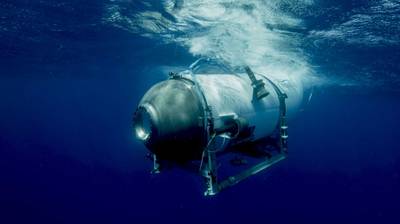Search for Missing Titanic Sub Focuses on Area Where Sounds Detected
Rescuers searching for a missing submersible near the wreck of the Titanic on Wednesday concentrated their efforts on a remote area of the North Atlantic where a series of undersea noises have been detected, though officials cautioned the sounds may not have originated from the vessel.
With estimates suggesting the air supply on board the submersible could run out by Thursday morning, an international coalition of rescue teams has swept a vast expanse of the ocean for signs of the Titan, which disappeared on Sunday while taking five people deep into the ocean to visit the century-old wreck as part of a tourist expedition.
The U.S. Coast Guard said remotely operated vehicle (ROV) searches were deployed in the area where Canadian aircraft recorded the noises using sonar buoys on Tuesday and Wednesday.
Coast Guard Captain Jamie Frederick said at a press conference that analysis of the noises has been "inconclusive."
"We don't know what they are, to be frank with you," he said. "We're searching in the area where the noises were detected."
Even if the submersible is located, retrieving it presents huge logistical challenges, given the extreme conditions miles below the surface.
Teams from the United States, Canada and France have searched more than 10,000 square miles (25,900 square km) of open sea, roughly the size of Lebanon or the U.S. state of Massachusetts.
The 22-foot (6.7-meter) submersible Titan, operated by U.S.-based OceanGate Expeditions, began its descent at 8 a.m. (1200 GMT) on Sunday. It lost contact with its parent surface vessel during what should have been a two-hour dive to the Titanic.
The submersible had 96 hours of air, according to the company's specifications, which would mean the oxygen could run out by Thursday morning. But experts say the air supply depends on a range of factors, including whether the submersible remains intact and still has power.
The wreck of the British ocean liner, which sank when it hit an iceberg on its maiden voyage in 1912, lies on the seabed at a depth of about 12,500 feet (3,810 meters). It is about 900 miles (1,450 km) east of Cape Cod, Massachusetts, and 400 miles south of St. John's, Newfoundland.
Those aboard the submersible, the highlight of a tourist adventure that costs $250,000 per person, included British billionaire and adventurer Hamish Harding, 58, and Pakistani-born businessman Shahzada Dawood, 48, with his 19-year-old son Suleman, who are both British citizens.
French explorer Paul-Henri Nargeolet, 77, and Stockton Rush, founder and chief executive of OceanGate Expeditions, were also reported to be on board.
A friend of Harding, Jannicke Mikkelsen, who has accompanied the British entrepreneur on other expeditions, told Reuters on Tuesday she was hoping for good news but was not optimistic. "It would be a miracle if they are recovered alive," she said.
(Reuters - Reporting by Steve Gorman and Joseph Ax; Additional reporting by Brendan O'Brien, Natalie Thomas, Aiden Nulty, Kanishka Singh, Ismail Shakil, Steve Scherer, Steve Holland, Daniel Trotta, Brad Brooks and Ariba Shahid; Editing by Raju Gopalakrishnan, Edmund Blair and Janet Lawrence)












